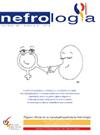Relevancia de las interacciones entre el complemento y el sistema de contacto de la coagulación en la enfermedad renal
IF 2.6
4区 医学
Q2 UROLOGY & NEPHROLOGY
引用次数: 0
Abstract
The complement system is a network of soluble and cell surface proteins primarily involved in innate immune responses. Complement signalling is essential for pathogen defence and homeostasis, but an activation-regulation imbalance can lead to tissue damage. This phenomenon has been implicated in kidney diseases such as atypical Haemolytic Uraemic Syndrome (aHUS), frequently associated with dysfunction of the complement regulator Factor H (FH). Physiologically, complement interacts with the coagulation, fibrinolysis, renin-angiotensin and kallikrein-kinin systems (KKS). The KKS is a proinflammatory and procoagulant cascade comprised of the protease prekallikrein, the coagulation factors XI (FXI) and XII (FXII), and the cofactor/substrate high-molecular-weight kininogen. KKS can be activated conformationally or proteolytically. KKS activation in vitro triggers a number of biochemical interactions between FXI, FXII, FH and other complement proteins that result in direct or secondary complement activation. These functional links point to an overall complement pro-activating role for the KKS that has implications for coagulation and immunity, but whose physiological consequences in vivo remain largely unexplored. This review aims to summarize the main physiopathological events of KKS activation in the context of complement-mediated kidney disease, with particular emphasis in aHUS.
肾病中补充剂与凝血接触系统相互作用的相关性
补体系统是一个由可溶性蛋白和细胞表面蛋白组成的网络,主要参与先天免疫反应。补体信号对病原体防御和体内平衡至关重要,但激活调节失衡可能导致组织损伤。这种现象与肾脏疾病有关,如非典型溶血性尿毒综合征(aHUS),通常与补体调节因子H (FH)功能障碍有关。生理上,补体与凝血、纤溶、肾素-血管紧张素和钾化钾素-激肽系统(KKS)相互作用。KKS是一种促炎和促凝级联蛋白,由蛋白酶prekallikrein、凝血因子XI (FXI)和XII (FXII)以及辅助因子/底物高分子量激肽原组成。KKS可以被构象或蛋白水解激活。体外KKS激活触发FXI、FXII、FH和其他补体蛋白之间的一系列生化相互作用,导致直接或次生补体激活。这些功能联系表明,KKS具有整体补体促激活作用,对凝血和免疫有影响,但其在体内的生理后果仍未得到充分研究。本综述旨在总结补体介导的肾脏疾病中KKS激活的主要生理病理事件,特别强调在aHUS中。
本文章由计算机程序翻译,如有差异,请以英文原文为准。
求助全文
约1分钟内获得全文
求助全文
来源期刊

Nefrologia
医学-泌尿学与肾脏学
CiteScore
3.40
自引率
7.70%
发文量
148
审稿时长
47 days
期刊介绍:
Nefrología is the official publication of the Spanish Society of Nephrology. The Journal publishes articles on basic or clinical research relating to nephrology, arterial hypertension, dialysis and kidney transplants. It is governed by the peer review system and all original papers are subject to internal assessment and external reviews. The journal accepts submissions of articles in English and in Spanish languages.
 求助内容:
求助内容: 应助结果提醒方式:
应助结果提醒方式:


